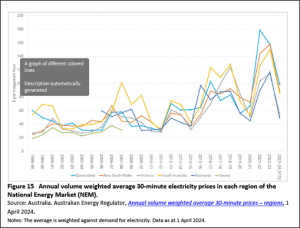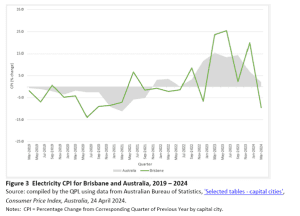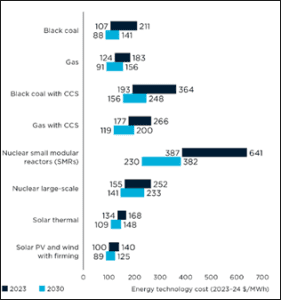This Noosa 360 update aims to address the following questions:
- How do Queensland electricity prices compare to other States?
- How will the move to renewables impact the cost of electricity?
Below in italics is the research we have conducted to answer these questions, however we would appreciate any feedback regarding from Noosa State Electorate residents including research that reaches a different conclusion. Any thoughts can be emailed to us via noosa@parliament.qld.gov.au.
How do Queensland electricity prices compare to other states?
Wholesale prices, Annual from 1999 to April 2024
The Australian Energy Regulator produces statistics on the wholesale electricity prices. The chart below provides the history of whole prices for the last twenty years (Queensland is light blue):
(It should also be noted that wholesale prices make up only one third of the final price, the other two thirds are transmission and retail costs).
Australian Competition and Consumer Commission (ACCC) electricity prices inquiry annual prices, 2022-23
The ACCC has undertaken an inquiry into electricity prices and has reported on consumer prices in the inquiry report. The latest report covers the years 2022 and 2023.
The chart below provides data on average prices for selected States for the normal prices, called flat rate, and for the flat rate and controlled load (the controlled load is a lower price at certain times on a separate circuit, for example running the hot water on a circuit that only comes on at night).
Data shows South East Queensland prices (rural/regional prices are not covered by the ACCC).
Source: ACCC.
Australian Bureau of Statistics – Consumer Price Index (CPI)
Another measure of electricity costs is inflation, as measured by the CPI. It cannot be used to make direct comparisons as it only measures changes in prices not absolute prices (the index starts with each states prices at 100 regardless of the actual prices, and measures changes from there).
The chart below CPI price changes for electricity for Brisbane vs all of Australia over the last five years:
Source: Source: Australian Bureau of Statistics, ‘Selected tables – capital cities’, Consumer Price Index, Australia, 24 April 2024.
Will renewables impact the cost of electricity?
The GenCost 2023-24 Report, which is produced by CSIRO and the Australian Energy Market Operator (AEMO) provides information on the costs of producing electricity for a range of different generation types:
Please note that generation costs are not the only costs of producing electricity for consumers, there is also the integration costs of renewables (power lines, batteries, pumped hydro, grid stabilisation. etc).
The Australian Energy Market Operator (AEMO) and associated regulators have been planning for the transition to renewables and their integration into the grid. In the 2024 Integrated System Plan they designate an Optimal Development Path which considers the required investment in renewable generation as well as the development of transmission (10,000kms required), firming capacity (such as batteries) etc.
The CEO of AEMO said is a speech:
“Consistent with our previous reports and publications, the 2024 ISP confirms that renewable energy connected with transmission and distribution firmed with storage, and backed up by gas-powered generation is the lowest-cost way to supply electricity to homes and businesses as Australia transitions to a net zero economy.”
The CEO of Alinta (Australian energy firm), Jeff Dimery has recently been quoted in an ABC article on this issue:
“building the wind and solar farms at the scale required to replace coal, together with the batteries needed to store the power, and the new network of transmission lines to distribute that power to consumers will involve tens of billions of dollars’ worth of investment. The Australian Energy Market Operator’s own figures suggest the transition will cost around $383 billion between now and 2050.
When asked who pays, Dimery replied: ‘it all comes from consumers, whether through the bill directly or through the tax base.’
This is not an argument against the transition, Dimery says: replacing coal with coal would cost even more.”
As mentioned above, we would appreciate any feedback on the information from Noosa State Electorate residents via noosa@parliament.qld.gov.au.
Further information
Our previous cost of living Noosa 360 update is available at www.sandybolton.com/cost-of-living-june-2023
For a Noosa specific summary of the 2024-25 State Budget and Sandy’s full budget reply speech in Parliament, please visit www.sandybolton.com/budget-2024-25-summary.
Updates on many local matters are available on Noosa 360 at www.sandybolton.com/noosa360. To receive information straight to your email inbox, please subscribe to our monthly newsletter via www.sandybolton.com/newsletters. This also ensures you receive any future Noosa related surveys or polls.




